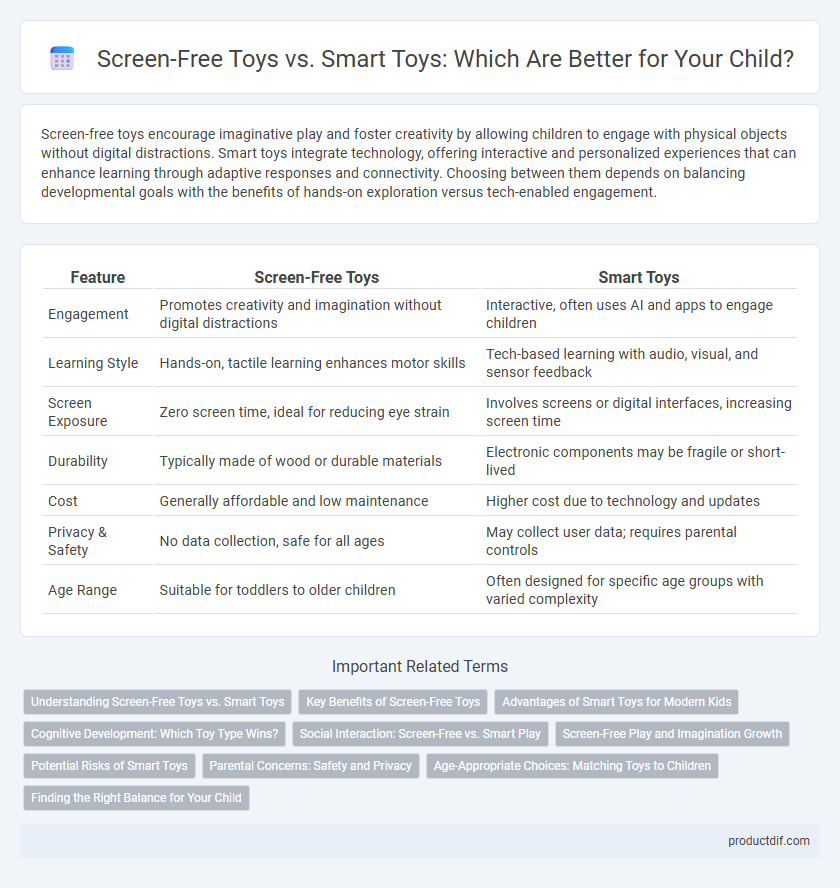Screen-free toys encourage imaginative play and foster creativity by allowing children to engage with physical objects without digital distractions. Smart toys integrate technology, offering interactive and personalized experiences that can enhance learning through adaptive responses and connectivity. Choosing between them depends on balancing developmental goals with the benefits of hands-on exploration versus tech-enabled engagement.
Table of Comparison
| Feature | Screen-Free Toys | Smart Toys |
|---|---|---|
| Engagement | Promotes creativity and imagination without digital distractions | Interactive, often uses AI and apps to engage children |
| Learning Style | Hands-on, tactile learning enhances motor skills | Tech-based learning with audio, visual, and sensor feedback |
| Screen Exposure | Zero screen time, ideal for reducing eye strain | Involves screens or digital interfaces, increasing screen time |
| Durability | Typically made of wood or durable materials | Electronic components may be fragile or short-lived |
| Cost | Generally affordable and low maintenance | Higher cost due to technology and updates |
| Privacy & Safety | No data collection, safe for all ages | May collect user data; requires parental controls |
| Age Range | Suitable for toddlers to older children | Often designed for specific age groups with varied complexity |
Understanding Screen-Free Toys vs. Smart Toys
Screen-free toys encourage imaginative play and physical activity, fostering creativity and social skills without electronic distractions. Smart toys integrate technology like AI and sensors to offer interactive learning experiences and personalized feedback, enhancing cognitive development. Choosing between them depends on balancing developmental goals with screen time preferences for children's growth.
Key Benefits of Screen-Free Toys
Screen-free toys promote creativity, fine motor skills, and social interaction by encouraging imaginative play without digital distractions. They reduce eye strain and support healthy brain development by engaging children in hands-on activities. Screen-free toys also foster better focus and problem-solving abilities through tactile learning experiences.
Advantages of Smart Toys for Modern Kids
Smart toys enhance cognitive development through interactive learning experiences powered by artificial intelligence and adaptive algorithms. These toys promote personalized education by responding to a child's unique pace and preferences, fostering creativity and problem-solving skills. Integration with modern technology encourages digital literacy, preparing children for a tech-driven future.
Cognitive Development: Which Toy Type Wins?
Screen-free toys such as puzzles, building blocks, and art supplies stimulate creativity, problem-solving, and fine motor skills, fostering deeper cognitive development in children. Smart toys, equipped with interactive features and adaptive learning algorithms, provide personalized educational content that can enhance memory and language skills but may limit imaginative play. Research indicates that while both toy types contribute to cognitive growth, screen-free toys more effectively promote critical thinking and independent learning in early childhood.
Social Interaction: Screen-Free vs. Smart Play
Screen-free toys promote face-to-face social interaction by encouraging cooperative play, imagination, and verbal communication among children. Smart toys, equipped with digital interfaces and AI, often create solo play experiences but can offer interactive features that simulate social responses. Evaluating the balance between direct human engagement and technology-driven interaction helps parents choose toys that foster meaningful social development.
Screen-Free Play and Imagination Growth
Screen-free toys encourage imagination growth by prompting children to create stories and scenarios without digital prompts, enhancing cognitive development and problem-solving skills. Traditional toys like building blocks, puzzles, and dolls foster hands-on interaction and sensory exploration, which are crucial for brain development. Research shows that screen-free play reduces overstimulation and improves attention spans, promoting deeper learning and creativity in children.
Potential Risks of Smart Toys
Smart toys often collect extensive data through microphones, cameras, and internet connectivity, raising significant privacy and security concerns. Vulnerabilities in smart toy software can expose children to hacking, unauthorized surveillance, or inappropriate content. Screen-free toys, by contrast, eliminate these risks by encouraging imaginative play without digital interaction.
Parental Concerns: Safety and Privacy
Parents prioritize safety and privacy when choosing between screen-free toys and smart toys, often favoring those without internet connectivity to avoid data breaches and unauthorized access. Screen-free toys reduce exposure to digital risks, while smart toys require rigorous scrutiny of encryption, data collection policies, and compliance with regulations like COPPA. Ensuring a toy's safety certification and transparent privacy practices remains crucial for protecting children's personal information and fostering secure play environments.
Age-Appropriate Choices: Matching Toys to Children
Age-appropriate choices in toys are crucial for fostering development and engagement; screen-free toys like building blocks and puzzles enhance creativity and fine motor skills for toddlers and preschoolers. Smart toys equipped with interactive features and educational content suit older children by supporting cognitive growth and problem-solving abilities. Matching toys to children's developmental stages ensures optimal learning experiences and balanced screen time.
Finding the Right Balance for Your Child
Screen-free toys foster creativity and hands-on learning by encouraging imagination and physical activity, which are essential for early childhood development. Smart toys incorporate technology to enhance interactive play and adaptive learning, supporting cognitive skills and problem-solving in a digital age. Finding the right balance involves selecting toys that promote both traditional play and technological engagement, tailored to your child's developmental needs and screen time limits.
Screen-free toys vs smart toys Infographic

 productdif.com
productdif.com